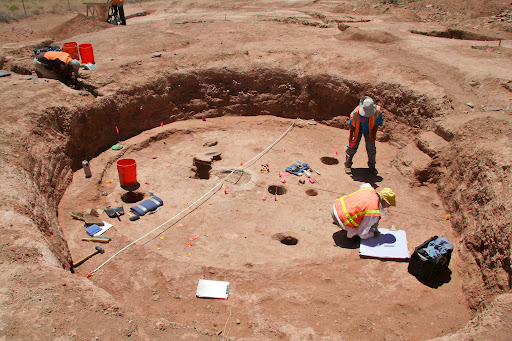ADOT team works to preserve history
ADOT team works to preserve history

A look at a site under investigation near SR 77.
If you haven’t already noticed, we really like blogging about dirt!
Just take a look through our archives and you can read about how we move dirt, why it’s used in construction and even the circumstances under which we “paint” it green!
One thing we’ve never touched on is what might be lying beneath all that dirt…
You see, ADOT does a lot of digging, but we have to be very careful not to disturb any historic (or prehistoric) sites that could be at a potential project site.
That’s where the ADOT Historic Preservation Team comes in. As a part of ADOT’s Environmental Planning Group, this team is in place to make sure all ADOT projects adhere to state and federal historic preservation laws.
Cultural preservation doesn’t just make good sense – it’s the law
ADOT Historic Preservation Specialist Linda Davis explains that in 1966, the National Historic Preservation Act was passed to protect historic properties from any damage caused by the actions of federal agencies. As a result of the national act, Arizona established the State Historic Preservation Act in 1982 to protect cultural resources from the activities of state agencies.
That means whether a highway project is even partially funded with federal or state money, it is subject to these laws that are designed to preserve history and manage our cultural resources.
How ADOT identifies and preserves the state’s historic properties
Every ADOT project involves a cultural resource assessment, which includes an initial records search (Davis says there are many resources available to the team that can provide information on whether or not a project area has already been surveyed to identify historic properties). If the project area has not previously been surveyed, a consultant is hired to perform the survey.
When historic properties are identified within a project area, the potential project effects on the property are evaluated.
“We look at the footprint of the project … where it is, what they’re going to do and how they’re going to do it,” she said.
If the evaluation indicates that the project may have an adverse effect on an historic property, efforts are made to avoid the property. If that’s just not possible, mitigation measures are developed depending on the type of property affected. For example, steps are taken to remove and preserve any artifacts from prehistoric sites (also called data recovery) or in the case of historic buildings and structures, a thorough documentation is conducted.
ADOT consults with the State Historic Preservation Office, Native American Tribes, land managing agencies and other stakeholders to make sure that findings and conclusions satisfy local and federal laws, including the National Historic Preservation Act.
What do they find out there?
Believe it or not, travel routes haven’t changed that much over time, said Davis, adding her team regularly comes across prehistoric trails, historic roads, prehistoric artifact scatters and habitation sites, historic trash scatters, historic buildings and historic landscapes.
Even within thriving municipalities that have been developed for years, there are prehistoric habitation sites, prehistoric canals, historic districts, and historic road systems (that include Apache Trail and Route 66).
“Arizona is rich with historic properties,” Davis said.
For more information on the historic Preservation Team, check out the Environmental Planning Group’s web page.
And, be sure to stay tuned … tomorrow we’ve got a video examining an actual site off of SR 77 that currently is under investigation.

